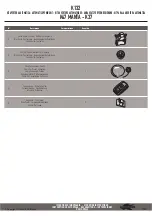
Set up Outputs, Test, and Run
Checker has two user-configurable output lines:
Output 0
and
Output 1
. You can configure
Checker to send a signal on either line when a part is detected, passed, or failed, or you can
disable the output line.
Test your job at production speed to make sure that good parts pass and bad parts fail. After
testing, adjust the timing of the job’s output signals as required. Before disconnecting the PC from
Checker, make sure to save your job to Checker and to the PC.
To put Checker to work, enter Run mode, disconnect the USB cable, and replace the rubber plug
over the USB connector.
Connecting Checker
Power
Part Detect Signal Input
Output 0 and Output 1
4
+
–
+ Red
–
Black
24 VDC
Voltage:
+24 VDC (22-26 VDC)
Current:
150 mA max
+
–
White w/orange stripe
Solid orange
24 VDC
Trigger ON
: +24 VDC (5 mA)
Trigger OFF
: < 2 VDC (<1.5 mA)
Protection:
Opto-isolated,
White w/orange stripe
Solid orange
Output
DC common
+VDC
Photoelectric sensor
+
24 VDC
–
Example: Connecting a Photoelectric sensor as an External Trigger
polarity-independent
Output 0
: Blue & White w/Blue Stripe
Output 1
: Gray & White w/Gray Stripe
Output
: Solid-state switch rated at
Max off leakage current
: 200 µA
Protection:
Opto-isolated. Protected
+
–
+ White w/color stripe
– Solid color
24 VDC
Load
100 mA max
Max voltage drop
: 3.5 VDC @ 100 mA
resistive
load
Example: Connecting to a PLC
White w/blue
Gray –
White w/gray
Blue –
+
–
24 VDC
Common
PLC
Input 0
Input 1
Input 7
from short circuit, overcurrent,
and reverse polarity.
+
–
+ White w/color stripe
– Solid color
24 VDC
Load
100 mA max
Method 2:
Method 1:
100 mA and 24 VDC max
Содержание Checker 101
Страница 1: ...Quick Reference...
























